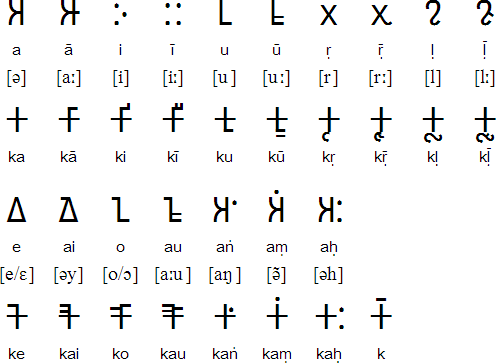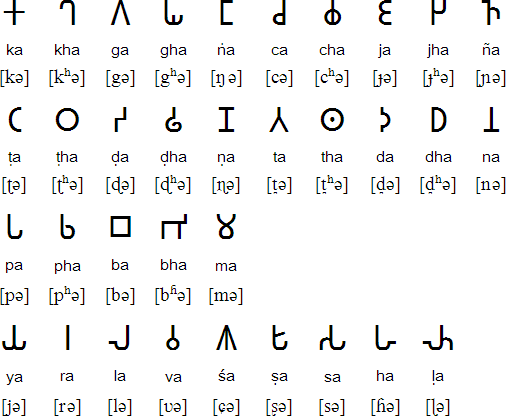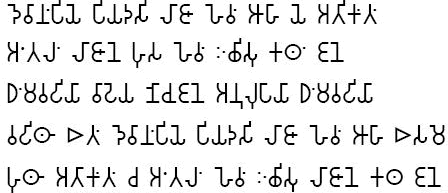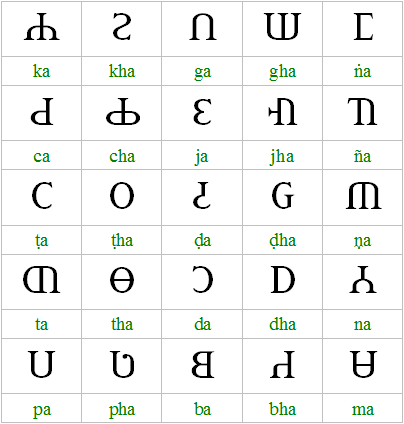|
Welcome to Dhammapada In Tamil
This book is published by BPS, and you can contact them to obtain a hard copy. BPS Tel: 081 2237283 Tel/Fax: 081 2233679 |
Mr.M.N.Mohideen |
Dhammapada In Tamil
Supreme Court to examine plea on EVM (Electronic Voting Machines) on priority

Dhammapada In Tamil
Supreme Court to examine plea on EVM (Electronic Voting Machines) on priority

Dhammapada In Tamil
Supreme Court to examine plea on EVM (Electronic Voting Machines) on priority

Supreme Court to examine plea on EVM (Electronic Voting Machines) on priority

Supreme Court to examine plea on EVM (Electronic Voting Machines) on priority





Brāhmī Alphabet
modern alphabets, and of a number of other
alphabets, such as Khmer and Tibetan.
It is thought to have been modelled on the Aramaic
or Phoenician alphabets, and appeared in Jambudvipa sometime before 500 BC.
The earliest known inscriptions in the Brāhmī alphabet are those of
King Asoka (c.270-232 BC), third monarch of the Mauryan dynasty.
Brāhmī was used to write a variety of languages, including Prakrit.
Notable features
- Type of writing system: abugida - each letter represents a consonant with an
inherent vowel. Other vowels were indicated using a variety of diacritics
and separate letters.
- Letters are grouped according to the way they are pronounced.
- Many letters have more than one form.
- Direction of writing: left to right in horizontal lines
Vowels and vowel diacritics

Consonants

Sample text


This is an experimental script for Pali, the ecclesiastical language of Buddhism.
Pali is normally written in the Sinhala, Khmer, Burmese, Devanagari,
Lao or Thai scripts, or with the Latin alphabet using diacritics.
This script has a Classical serif font style,
with shapes based on those of ancient Brahmi and Pallava,
which were the ancestors of the Indic scripts just mentioned.
It aims at a unified, linear effect, without complicated
vowel placement or diacritics. The name means Letters of the Sage.
Consonants
Most letters are quite easily recognizable from their counterparts in other Indic scripts.
As with almost all Indic scripts, and different from Ariyaka,
consonants have an inherent short /a/ if no vowel letter is written.


The glottal plosive acts as a prefix for initial vowels, as is found in many Indic scripts.
The two extra /s/ glyphs are for Sanskrit words. The dotted /m/ suffix is a vowel nasalizer,
being a common Pali morpheme. It may be noted the retroflex laterals are not encoded;
they are considered allophones of the retroflex plosives, emerging in speech when between vowels.
Vowels
The written vowels follow their consonants in all cases,
in a linear, single-channel manner; this is unlike most Indic scripts,
whose vowels end up all over the place. The /ai/ and /au/ glyphs are for Sanskrit words.
A “no vowel” mark may be used to cancel the inherent short /a/,
as is required for consonants which close a syllable.

Punctuation etc
The “no vowel between” mark is for non-final, cluster or sandhi situations
where the consonants run together. Where a consonant is doubled, a colon-shape is used in place of the
second component. Note that where an aspirated consonant is doubled, an unaspirated form arises as the first
component of the gemination; in Akkhara Muni, only the aspirated consonant is written, and any loss
of aspiration due to doubling is ignored in writing.

Please note that Akkhara Muni seeks to capture the phonetics of the language,
and not duplicate existing systems of spelling. Even so, some further work may be required to
deal with all phonological conditions adequately, and/or simplify common morphological situations.
Examples
These are based on my own poor reading of the Romanized Pali, and so may not perfectly reflect the
classical pronunciation. Ideally, we will want to read and hear something close to what the Buddha
himself might have said.
1. This is the first verse of the Dhammapada.


“Mind precedes all mental states, mind is their chief, they are all mind-wrought.
If a person speaks or acts with an impure mind,
Suffering follows him like the wheel follows the foot of the ox.”
2. This is the 154th verse of the Dhammapada.

“Oh house-builder! You are seen, you shall build no house (for me) again.
All your rafters are broken, your roof-tree is destroyed.
My mind has reached the unconditioned; the end of craving has been attained.”
A version of this page can also be found on
Omniglot.
See also:
Thai and Lao for writing Pali, and
the Ariyaka script created by King Rama IV of Siam.
Dhammapada In Tamil
https://in.pinterest.com/pin/194288171407965404/
-




https://in.news.yahoo.com/robot-monk-blends-science-buddhism-chinese-temple-022046666.html
Robot monk blends science and Buddhism at Chinese templeBy Joseph CampbellReuters23 April 2016
https://www.rt.com/viral/340638-buddha-robot-longquan-beijing/
Buddha-bot: Chinese temple enlists mini monk robot to boost teachings (VIDEO)



Supreme Court to examine plea on electronic voting machines on priority

Reality of Indian Voting Machines (EVMs) - Dr. Subramanian Swamy
“Hari Prasad should be given bharat ratna for demonstrating that Electronic Voting Machines of India can be tampered. Instead they put him in jail”
99.9% All Aboriginal Awakened Societies are aware of the fact that Mad Murderer of democratic institutions (Modi) of Bevakoof Jhoothe Psychopaths (BJ(P)Ltd Private Limited remotely controlled by just 0.1% intolerant, violent, militant, ever shooting, mob lunching, number one terrorists of the world, lunatic, mentally retarded, foreigners RSS) only will win all elections as long as the Fraud EVMs (Evil Voting Machines) are used despite the face that the RSS demanded Ballot papers when the BJP was in opposition. Like USA of Ballot Papers are used chitpavan brahmins will get only 0.1% votes. If the foreigners chitpavan brahmins are forced to quit Prabuddha Bharat democracy, liberty, equality and fraternity as enshrined in our marvelous modern Constitution will be saved.
RSS has demanded re-introduction of ballot paper system in elections, claiming that electronic voting machines are not tamper-proof and ruling parties can “misuse” them to get desired results in polls.
“Can’t EVMs be tampered with? Experts say that it (tampering with) is possible, though Election Commission has unnecessarily made it a matter of prestige,” an editorial in the recent issue of RSS mouthpiece Organiser said.
The Sangh said that if Election Commission believed that EVMs cannot be tampered with, there was no reason for it to feel troubled over conducting a test of the machine in public.
RSS has demanded re-introduction of ballot paper system in elections, claiming that electronic voting machines are not tamper-proof and ruling parties can “misuse” them to get desired results in polls.
“Can’t EVMs be tampered with? Experts say that it (tampering with) is possible, though Election Commission has unnecessarily made it a matter of prestige,” an editorial in the recent issue of RSS mouthpiece Organiser said.
The Sangh said that if Election Commission believed that EVMs cannot be tampered with, there was no reason for it to feel troubled over conducting a test of the machine in public.
It said, “it is unfortunate that its expert P V Indiresan has adopted an unscientific approach over the issue (of testing of the machines) as if his views are the last word about EVMs and so there was no necessity to review or improve it.”
The editorial claimed that voters across the world doubt EVMs. Countries like Netherland, Italy, Germany and Ireland, which initially adopted EVMs, have banned them because they believe that these can “easily be rigged”.
It alleged that ruling party can tamper with the EVMs to achieve desired results in election.
Expressing his agreement with the Sang’s views on the issue, BJP spokesman Ravi Shankar Prasad said that EVMs have been in use during elections for last ten years and time has now come to ascertain its credibility.
Reality of Indian Voting Machines (EVMs) - Dr. Subramanian Swamy
This is an experimental script for Pali, the ecclesiastical language of Buddhism.
Pali is normally written in the Sinhala, Khmer, Burmese, Devanagari,
Lao or Thai scripts, or with the Latin alphabet using diacritics.
This script has a Classical serif font style,
with shapes based on those of ancient Brahmi and Pallava,
which were the ancestors of the Indic scripts just mentioned.
It aims at a unified, linear effect, without complicated
vowel placement or diacritics. The name means Letters of the Sage.
Consonants
Most letters are quite easily recognizable from their counterparts in other Indic scripts.
As with almost all Indic scripts, and different from Ariyaka,
consonants have an inherent short /a/ if no vowel letter is written.
The glottal plosive acts as a prefix for initial vowels, as is found in many Indic scripts.
The two extra /s/ glyphs are for Sanskrit words. The dotted /m/ suffix is a vowel nasalizer,
being a common Pali morpheme. It may be noted the retroflex laterals are not encoded;
they are considered allophones of the retroflex plosives, emerging in speech when between vowels.
Vowels
The written vowels follow their consonants in all cases,
in a linear, single-channel manner; this is unlike most Indic scripts,
whose vowels end up all over the place. The /ai/ and /au/ glyphs are for Sanskrit words.
A “no vowel” mark may be used to cancel the inherent short /a/,
as is required for consonants which close a syllable.
Punctuation etc
The “no vowel between” mark is for non-final, cluster or sandhi situations
where the consonants run together. Where a consonant is doubled, a colon-shape is used in place of the
second component. Note that where an aspirated consonant is doubled, an unaspirated form arises as the first
component of the gemination; in Akkhara Muni, only the aspirated consonant is written, and any loss
of aspiration due to doubling is ignored in writing.
Please note that Akkhara Muni seeks to capture the phonetics of the language,
and not duplicate existing systems of spelling. Even so, some further work may be required to
deal with all phonological conditions adequately, and/or simplify common morphological situations.
Examples
These are based on my own poor reading of the Romanized Pali, and so may not perfectly reflect the
classical pronunciation. Ideally, we will want to read and hear something close to what the Buddha
himself might have said.
1. This is the first verse of the Dhammapada.
“Mind precedes all mental states, mind is their chief, they are all mind-wrought.
If a person speaks or acts with an impure mind,
Suffering follows him like the wheel follows the foot of the ox.”
2. This is the 154th verse of the Dhammapada.
“Oh house-builder! You are seen, you shall build no house (for me) again.
All your rafters are broken, your roof-tree is destroyed.
My mind has reached the unconditioned; the end of craving has been attained.”
A version of this page can also be found on
Omniglot.
See also:
Thai and Lao for writing Pali, and
the Ariyaka script created by King Rama IV of Siam.
https://in.pinterest.com/pin/194288171407965404/
https://in.pinterest.com/pin/194288171407965404/
|




https://in.news.yahoo.com/robot-monk-blends-science-buddhism-chinese-temple-022046666.html
Robot monk blends science and Buddhism at Chinese templeBy Joseph CampbellReuters23 April 2016
https://www.rt.com/viral/340638-buddha-robot-longquan-beijing/
Buddha-bot: Chinese temple enlists mini monk robot to boost teachings (VIDEO)



|
|||||||
|
|



https://in.news.yahoo.com/robot-monk-blends-science-buddhism-chinese-temple-022046666.html
Robot monk blends science and Buddhism at Chinese templeBy Joseph CampbellReuters23 April 2016
https://www.rt.com/viral/340638-buddha-robot-longquan-beijing/
Buddha-bot: Chinese temple enlists mini monk robot to boost teachings (VIDEO)


















